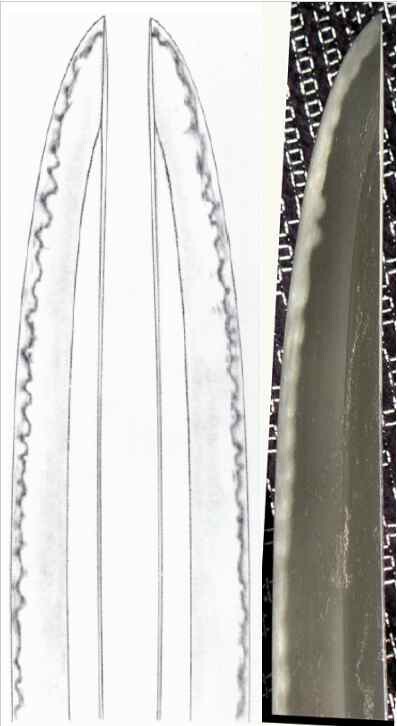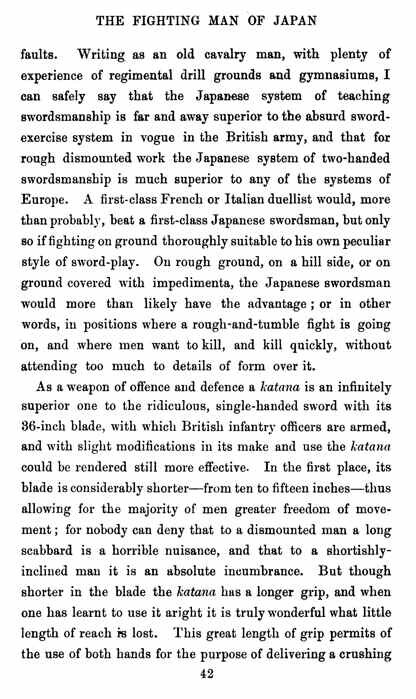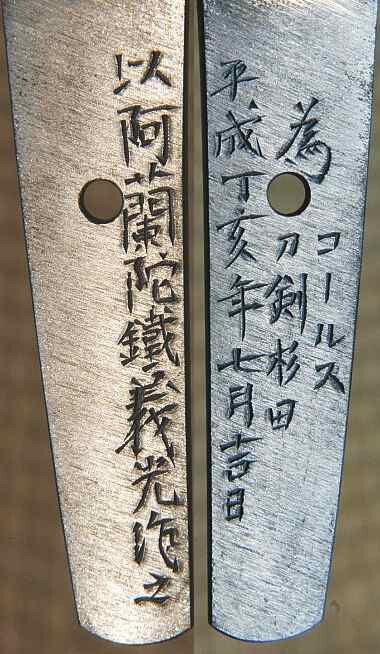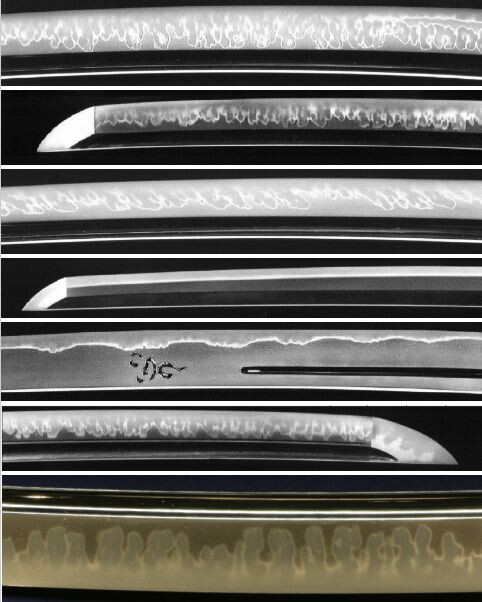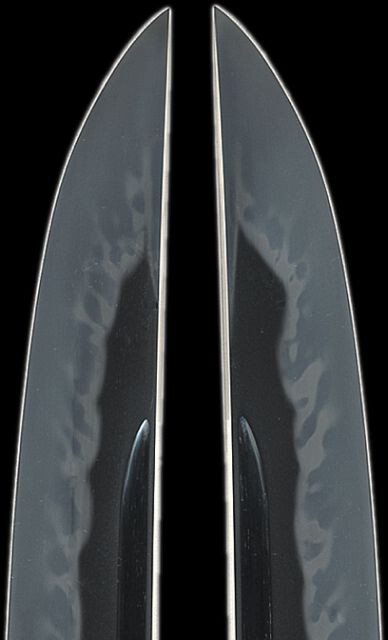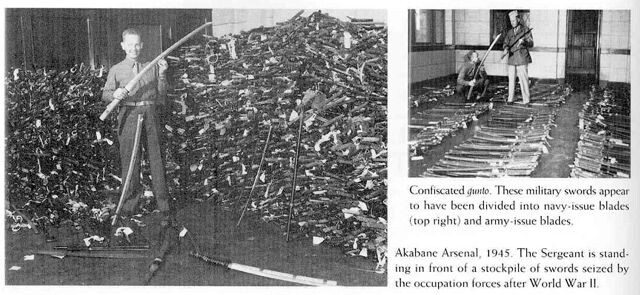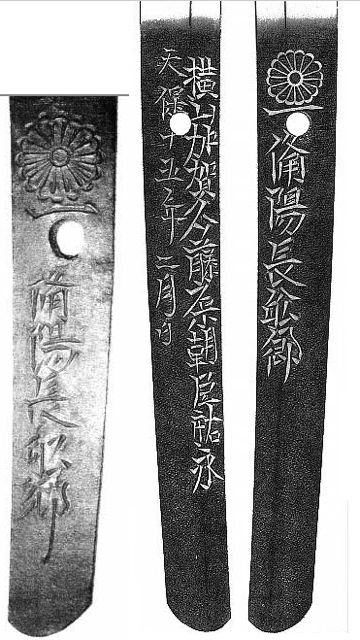-
Posts
1,029 -
Joined
-
Last visited
Content Type
Profiles
Forums
Events
Store
Downloads
Gallery
Everything posted by Eric H
-
-
This is a JuTo Naginata naoshi, suriage Nakago, 74 cm, by this Masamitsu ...btw other Japanese sources say : the son of Kanemitsu... with itame hada mixed with nagare hada and a pronounced bo utsuri and thin Kasane. Eric
-

To Good To Be True Deal ???
Eric H replied to Icepic's topic in Auctions and Online Sales or Sellers
-
Well, this is just the point, it insinuates that as per definition a Katana, 2 shaku at least, but shorter than 70 cm isn‘t a „real“ Nihonto...what is it than? To wear/carry swords of Katana-size was prohibited to merchants, i.e. commoners. Aside from the technical aspects of sword smithing which are fully agreed I want to point to the following article "Was chonin class in Edo period allowed to wear/carry swords?" by Dr. T http://www.una.edu/faculty/takeuchi/DrT ... hon_to.htm Eric
-
It is a Katana by Ippei Yasuyo possibly conceived for single hand use (katate uchi) and quick draw (nuki uchi). I have in my library enough examples of renowned swordsmiths with swords differing considerably in lengths. As a convincing example two swords by Kazusa no Suke Kaneshige, of course both ubu: Katana 61.7 cm Katana 76.2 cm with Tameshigiri I don‘t want to add the pictures for not deviate the discussion. However one remark. Those who have read the "Gorin no Sho" might remember that the legendary swordsman Musashi never gave an importance to the lengths of his swords, in other words the length of a sword in a fight is of secondary importance, the fighters capability (in all aspects) is decisive. Incomprehensible for me, a great majority of Nihonto collectors cuddle the belief, that a "good" Katana must measure at least 70 cm. Eric
-
-
For comparison a Tanto by Uda Kunimune, 21.6 cm The Uda school's Tanto and Wakizashi boshi are midarekomi, tsukiage, and the tip is sharp and there is a long return, (or the midarekomi tip has a sharp peak). This resembles the Samonji school, and this is one of their characteristic styles. Their Tanto and Wakizashi nakago are broad wide tips with kurijiri, the nakago-mune is round, many of yasurime are katte-sagari, and the signatures are usually on the omote side, under the mekugi-ana, along the center. (Shijo Kantei No 634) Eric
-

The Fighting Man of Japan
Eric H replied to Baka Gaijin's topic in General Nihonto Related Discussion
-
Kodachi... Tachi shorter than 2 shaku... is simply defined by its length. This Kageyasu Kodachi displays contrarily to the above said a deep sori, 1.35 cm, and a marked tapering of 0.91 cm...regarding its length :| Eric
-

Shinsakuto ...... are they Nihonto?
Eric H replied to sanjuro's topic in General Nihonto Related Discussion
No rule without exception Wakizashi by Ono Yoshimitsu using "oranda tetsu" without watetsu. Article NAMBAN TETSU PROJECT : http://www.tokensugita.com/NT.htm Eric -
At a quick glance I cannot make out a blade papered with hagire, but a blade by Kiyomaro with hagire with Sayagaki by Tanobe Michihiro which is valid as much as a NBTHK paper. Eric
-
At least one member has had a Ono Yoshimitsu...test "A" ...if it was not meant to be a joke Eric
-

Shinsakuto ...... are they Nihonto?
Eric H replied to sanjuro's topic in General Nihonto Related Discussion
The oldest smelting furnace discovered in Japan dates from the middle of the sixth century. Tamahagane is the impure base material for the Japanese sword and is produced from iron sand using a smelter called Tatara. It must be said that the Japanese sword cannot be produced without Tatara iron, i.e. Watetsu. (see Guido's article) Eric -
I suppose that the forgers identity at present is unknown. Well, the Nakago test gave evidence of the forgers skill, but how about the characteristics in the blade?... Hada, Hamon, Hataraki and so on...and how many blades approximately are proven to be gi-mei?... or have we to think of one blade? I can imagine to forge Yoshimitsu's characteristics must be very difficult. Some examples of Yoshimitsu's Hamon. Eric
-
I appreciate those friendly comments very much :D Eric
-
Obviously people are not interested to follow this topic. I tried to delete my last post but was not successful. Eric
-
-

Shinsakuto ...... are they Nihonto?
Eric H replied to sanjuro's topic in General Nihonto Related Discussion
Preservation of an old Craft Thank God that the late Dr. Junji Honma could convince General Mc Arthur on the artistic merits of the old Japanese sword and thus saving many hundreds of thousands of swords before destruction. Thereupon 1948 the NBTHK was founded by Dr. Honma and Dr. Sato. It is also true that on the background of Japans history it has been a honest ambition to make survive the old crafts like pottery, lacquer, weaving, dying, metalwork and so on... and in particular swordsmithing and the related crafts are logically involved. Shinsakuto are made by highly skilled craftsmen. These swords are made to be admired and appreciated as well as the old swords once worn by the Samurai, although the old swords are in the aura of the foretime and this makes them perhaps more attractive for a collector. Not any of them should be used except perhaps by qualified swordsmen. It is pathbreaking that Tanobe san has a large collection of shinsakuto. 50 years in the future or even earlier they will be much sought-after...and for sure... sword lovers will not die out. Shinsakuto are Nihonto, an art object as well as a weapon. Yes Eric -
Strictly speaking this is not accurate, the jiri of B is slightly curved, a suriage Nakago is mostly straight cut. The forger of Ono Yoshimitsu's swords must be extremely skillful, normally a smith's characteristics are present in the blade, his "handwriting", and the "mei" is like a concluding confirmation of its authenticity, and now it seems that minimal variations in the "mei" can be proof of the forgerie. However Yoshimitsu's swords are very expensive and a prospective buyer needs obviously an additional certificate by Mr. Ono. Eric
-
George, I have only that picture of the Nakago from the internet. It is in my opinion quite normal that in the career of a Swordsmith his "mei" undergoes subtle changes, for instance as in "mitsu"... there are also other details. I have no access to the Kapp/Yoshihara book. Moreover it is most likely as Guido states, the "suriage style" Nakago points to a Utsushimono. In the picture I have attached on the left side is ...?...Sukezane. Perhaps a hint this sword is a work "after" Bizen Sukezane? Eric
-
-



